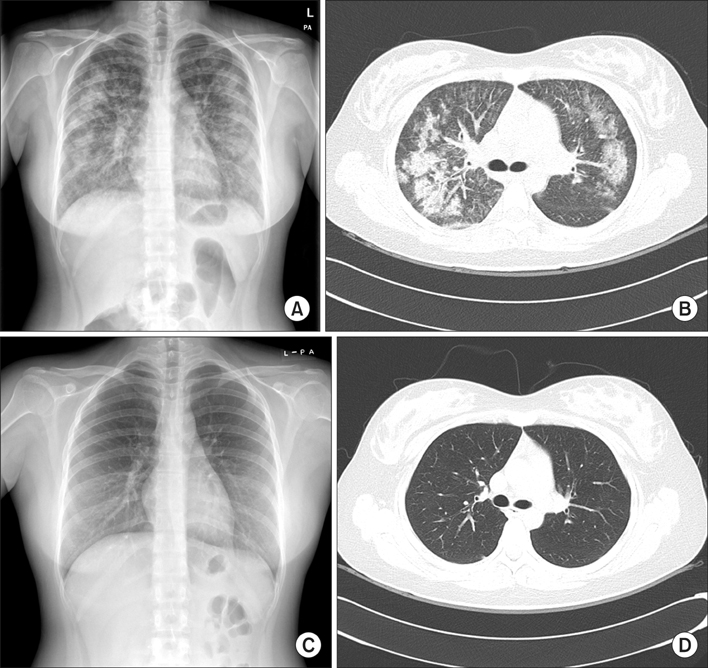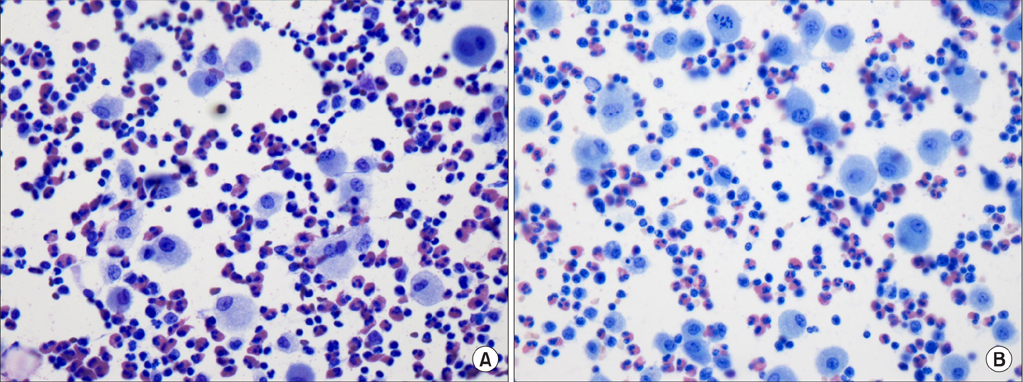Tuberc Respir Dis.
2014 Apr;76(4):188-191.
Acute Eosinophilic Pneumonia Following Secondhand Cigarette Smoke Exposure
- Affiliations
-
- 1Department of Internal Medicine, Ewha Medical Center and Ewha Medical Research Institute, Ewha Womans University School of Medicine, Seoul, Korea. medyon@ewha.ac.kr
- 2Department of Radiology, Ewha Medical Center and Ewha Medical Research Institute, Ewha Womans University School of Medicine, Seoul, Korea.
Abstract
- Acute eosinophilic pneumonia (AEP) is a disease characterized by an acute febrile onset, eosinophilia in bronchoalveolar lavage fluid, and a dramatic response to corticosteroids. Although many studies have reported a close relationship between direct cigarette smoking and AEP, few studies have identified an association between passive smoking and AEP. Here, we report a case of AEP in a 19-year-old female with cough, fever, and dyspnea after 4 weeks of intense exposure to secondhand smoke for 6 to 8 hours a day in an enclosed area.
MeSH Terms
Figure
Reference
-
1. Philit F, Etienne-Mastroianni B, Parrot A, Guerin C, Robert D, Cordier JF. Idiopathic acute eosinophilic pneumonia: a study of 22 patients. Am J Respir Crit Care Med. 2002; 166:1235–1239.2. Uchiyama H, Suda T, Nakamura Y, Shirai M, Gemma H, Shirai T, et al. Alterations in smoking habits are associated with acute eosinophilic pneumonia. Chest. 2008; 133:1174–1180.3. Shorr AF, Scoville SL, Cersovsky SB, Shanks GD, Ockenhouse CF, Smoak BL, et al. Acute eosinophilic pneumonia among US Military personnel deployed in or near Iraq. JAMA. 2004; 292:2997–3005.4. Watanabe K, Fujimura M, Kasahara K, Yasui M, Myou S, Kita T, et al. Acute eosinophilic pneumonia following cigarette smoking: a case report including cigarette-smoking challenge test. Intern Med. 2002; 41:1016–1020.5. Rhee CK, Min KH, Yim NY, Lee JE, Lee NR, Chung MP, et al. Clinical characteristics and corticosteroid treatment of acute eosinophilic pneumonia. Eur Respir J. 2013; 41:402–409.6. Komiya K, Teramoto S, Kawashima M, Kurosaki Y, Shoji S, Hebisawa A. A case of acute eosinophilic pneumonia following short-term passive smoking: an evidence of very high level of urinary cotinine. Allergol Int. 2010; 59:421–423.7. Yoo KD, Jang W, Hong JH, Lee HP, Choi SJ, Choi SB. Acute eosinophilic pneumonia caused by passive smoking. Korean J Med. 2009; 77:508–511.8. Janz DR, O'Neal HR Jr, Ely EW. Acute eosinophilic pneumonia: a case report and review of the literature. Crit Care Med. 2009; 37:1470–1474.9. Allen JN, Liao Z, Wewers MD, Altenberger EA, Moore SA, Allen ED. Detection of IL-5 and IL-1 receptor antagonist in bronchoalveolar lavage fluid in acute eosinophilic pneumonia. J Allergy Clin Immunol. 1996; 97:1366–1374.10. Kuschner WG, D'Alessandro A, Wong H, Blanc PD. Dose-dependent cigarette smoking-related inflammatory responses in healthy adults. Eur Respir J. 1996; 9:1989–1994.11. Flouris AD, Metsios GS, Carrillo AE, Jamurtas AZ, Gourgoulianis K, Kiropoulos T, et al. Acute and short-term effects of secondhand smoke on lung function and cytokine production. Am J Respir Crit Care Med. 2009; 179:1029–1033.
- Full Text Links
- Actions
-
Cited
- CITED
-
- Close
- Share
- Similar articles
-
- Acute eosinophilic pneumonia caused by passive smoking
- New Onset Cigarette Smoking-Induced Acute Eosinophilic Pneumonia: Case Report and Review of the Literature
- A Case of Acute Eosinophilic Pneumonia Following Cigarette Smoking
- A Case of Smoking Induced Acute Eosinophilic Pneumonia
- Estimation of Secondhand Smoke Exposure in Clubs Based on Urinary Cotinine Levels



